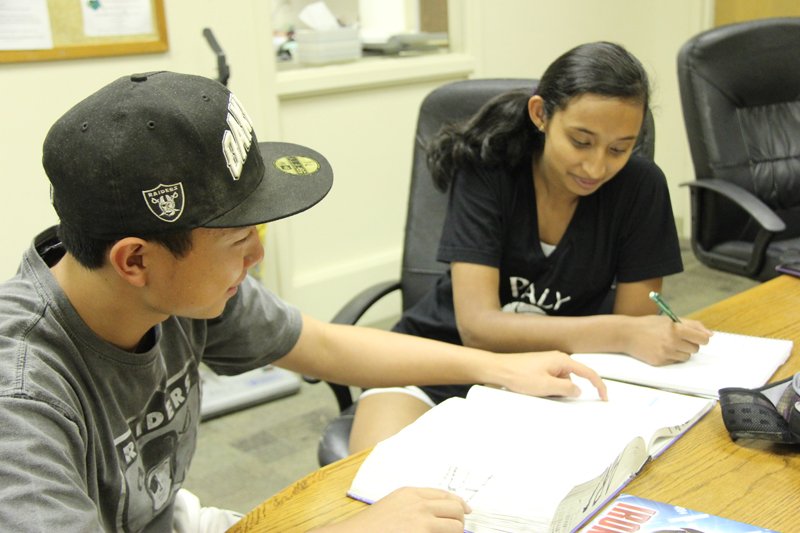Students rely too much on help outside of class
Ahmed Awadallah
Senior William Yang, a volunteer student tutor, helps junior Rudra Aiyar study in the Academic Resource Center for an upcoming Advanced Placement Biology test.
With grades always in the back of student’s minds, Palo Alto High School students are relying too much on tutors to get their desired grade.
Palo Alto Unified School District (PAUSD) has been ranked sixth in the state, according to the 2013 Growth Academic Performance Index (API), which is not surprising considering all the competition and high expectations students must fulfill.
Paly is known for its rigorous course curriculum, and many students are already accustomed to working hard and receiving undesired grades. However, those students who refuse to accept displeasing grades often choose to seek outside help. More and more tutoring centers are popping up in response to a higher demand among families with students enrolled within PAUSD. Junior Max Krawczyk has noticed the increase of these centers and has, though he admits that students should not depend on tutors, resorted to tutoring as well.
“These days everybody is getting tutored outside of school; I know a bunch of my friends take SAT classes at these private places,” Krawczyk said. “And so to stay competitive, you need your own source of outside tutoring otherwise you will get left behind in Palo Alto’s competitive academic environment.”
With developments in technology, tutoring no longer consists of driving to a center and sitting face-to-face with a tutor. Now, Skype allows students to get tutored in the comfort of their home, which makes help accessible to any students seeking additional academic support.
Khan Academy, a non-profit organization, is a perfect example of tutoring made easier. The faculty at Khan Academy have created a free library of videos posted on YouTube and on their website. These lectures cover a range of topics including math, chemistry, physics and more. With this format, students are able to watch course videos at any time of the day and repeat them as often as needed. This accessibility leads students to rely on outside help and allows them to slack off in class. By knowing that they will eventually need to allocate time outside of class to relearn the material with a tutor, students will get the idea that learning in school is no longer of importance, possibly leading to an increase in cuts, tardies and unfocused students in the classroom.
Palo Alto students are mainly considered in the upper class or upper middle class, so families are able to set aside parts of their income for tutoring and other outside help. The problem is not that students are getting the outside help they need, rather that lower-income students get an unfair disadvantage. Students with families that do not have thousands of dollars to annually spend on tutoring not only must work harder in class, but also must settle for less convenience. The time it takes a student to look up solutions and verify facts is significantly more time-consuming than others who just get the information told to them, leading to a huge time disadvantage for those who cannot afford tutors. It is almost like students can now pay for their good grades if they are unmotivated or lazy. Just because many families who live in Palo Alto can afford to pay tutors does not mean that students should take the service for granted and use it excessively.
“I think tutoring is great because it allows students to get the academic help they need and as it expands to more people it becomes more true,” senior Jared Filseth said. “Often times explaining to a class isn’t really working for them and they need more individual attention.”
Junior Gary Chen agrees with Filseth.
“Tutoring is a good option because usually students don’t ask their teachers for help unless they’re really bold,” Chen said. “So with tutoring you can ask someone else who has been through everything, and the tutor will probably know more.”
If what Filseth and Chen say are true, either our teachers are not captivating their students in the classroom, or students are just not paying enough attention in class. Students should not need to always resort to the help of outside tutors to get the grades they desire.
Your donation will support the student journalists of Palo Alto High School's newspaper

